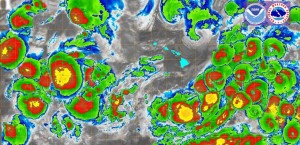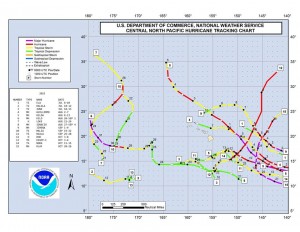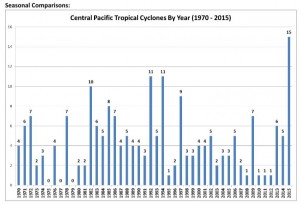2015 Hurricane Season Breaks Numerous Records

Satellite mapping overlay of all cyclones around the Hawaiian Islands. Image credit: US National Weather Service Honolulu & Central Pacific Hurricane Center. Click on image to view in greater detail.
The National Weather Service just released it’s summary of the 2015 hurricane season which officially ended on December 1st. This year, numerous records were broken with regard to tropical cyclone activity.
Due in part to a strong El Nino and warm ocean temperatures, hurricane season started earlier than usual and was more active than any other year on record. Fortunately, luck was on our side and none of the 15 tropical cyclones in the Central Pacific basin made landfall in the Hawaiian Islands this year.
This is the first year, since reliable record-keeping began in 1970, that fifteen tropical cyclones were active in the Central Pacific basin. The previous most active year(s) since 1970 were 1992 and 1994 with 11 tropical cyclones each. On average, 4 to 5 tropical cyclones develop or move across the central Pacific basin each year during hurricane season.
According to the CPHC, the United States Air Force Reserve’s 53rd Weather Reconnaissance Squadron, flew 34 total missions in the central Pacific in 2015 logging a total of 586.7 hours of flying time. This support accounted for over half of the nationwide total of hours flown (1141.4 hours) and a large portion of the total number of missions nationwide (96 missions).
The Central Pacific Hurricane Center compiled the list below to summarize the 2015 season. It lists the names of tropical cyclones, their lifecycle dates within the basin, and maximum wind speeds.
Name / Dates (UTC) / Max Wind
Tropical Storm Ela / July 8-10 / 45 mph
Tropical Storm Iune / July 10-13 / 40 mph
Tropical Storm Halola / July 10-12 / 55 mph
Hurricane Guillermo / August 2-7 / 105 mph
Hurricane Hilda / August 8-13 / 140 mph
Hurricane Kilo / August 20 – September 1 / 140 mph
Hurricane Loke / August 21-26 / 75 mph
Hurricane Ignacio / August 27 – September 4 / 145 mph
Hurricane Jimena / September 1-9 / 120 mph
Tropical Storm Malia / September 19-22 / 40 mph
Tropical Storm Niala / September 25-28 / 65 mph
Hurricane Oho / October 3-8 / 95 mph
Tropical Depression 8-C / October 3-4 / 30 mph
Tropical Storm Nora / October 11-15 / 60 mph
Hurricane Olaf / October 20-26 / 130 mph

Preliminary 2015 Hurricane Season track map of Tropical Cyclone activity in the Central Pacific. 15 Tropical Cyclones smashed the previous seasonal record of 11 set in both 1992 and 1994.
Central Pacific Hurricane Center list of select records for 2015:
- 5 Hurricanes (3 Major Hurricanes) in August – previous record 2
- 3 Tropical Storms in July – previous record 1
- Earliest tropical cyclone to develop to tropical storm strength in the central Pacific during hurricane season: Ela on July 9th. Previous record, Wali on July 17th, 2014.
- Kilo and Ignacio (while in the central Pacific basin) were part of a historic central and eastern Pacific outbreak – 3 major hurricanes (Jimena in east Pacific) at once for the first time on record. Kilo, Ignacio and Jimena were all Category 4 intensity concurrently. Prior to this, two concurrent Category 3 hurricanes, let alone Category 4, had never been recorded in the central Pacific basin.
- Olaf was the strongest central Pacific basin hurricane on record so late in the year.











